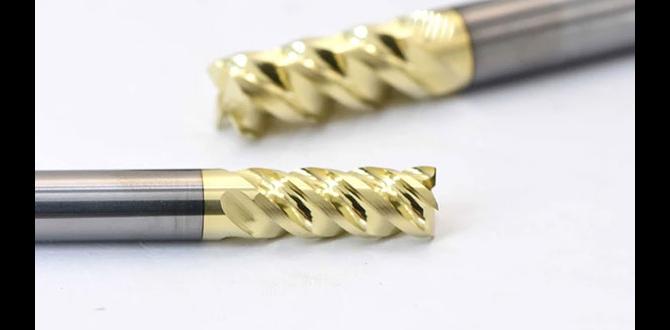Yes, a carbide end mill is proven effective for machining Inconel 625, especially when choosing the right type and applying proper machining parameters. Special grades of carbide, often with specific coatings, are crucial for handling this difficult-to-machine superalloy, offering higher Metal Removal Rates (MRR) and longer tool life compared to traditional mills.
Hey everyone, Daniel Bates here from Lathe Hub! If you’ve ever tried to machine Inconel 625, you know it can be a real beast. This super strong metal is amazing for high-temperature jobs, but it fights back when you try to cut it. Many beginners, and even some experienced folks, struggle to find the right tooling. You might be wondering, “Can a regular end mill even touch this stuff?” The answer is yes, but you need to be smart about it. I’m going to show you how the right carbide end mill can make Inconel 625 much more manageable. We’ll dive into what makes certain end mills so good for this tough material, and I’ll give you the straightforward, step-by-step guidance you need to get those cuts happening smoothly and safely in your workshop. Let’s get your milling projects on the fast track!
Understanding Inconel 625: Why It’s a Milling Challenge
Before we talk about end mills, let’s quickly touch on why Inconel 625 is so notoriously difficult to machine. It’s not your everyday aluminum or mild steel! Inconel 625 is a nickel-chromium-based superalloy. This means it’s designed for extreme environments – think aerospace engine parts, chemical processing equipment, and marine applications where high temperatures, corrosive elements, and immense pressure are the norm. These incredible properties come at a cost when it comes to machining.
Here’s what happens when you try to mill Inconel 625:
- Work Hardening: As soon as you start cutting, the material around the cut rapidly becomes much harder. This is like trying to cut through hardened steel – it dulls tools FAST and requires way more force.
- Low Thermal Conductivity: Inconel doesn’t let heat escape easily. Instead, the heat generated by the cutting action stays right at the tool tip. This extreme heat can soften or melt the cutting edge of your tool, leading to premature failure.
- Gummy Texture: It has a tendency to “gum up” on the cutting edge, rather than producing clean chips. This is frustrating and puts extra stress on the tool.
- High Strength and Toughness: Even at room temperature, Inconel 625 is incredibly strong and tough, requiring significant forces to deform and cut.
Because of these issues, using the wrong tooling or machining strategy can lead to broken tools, poor surface finish, and a lot of wasted time and money. That’s where the right carbide end mill comes in. For a deeper dive into the material properties, you can check out resources from organizations like the Nickel Institute, which provide detailed information on Inconel 625.
Why Carbide End Mills Shine for Inconel 625
So, if Inconel 625 is so tough, what makes a carbide end mill a good choice? The answer lies in the material properties of tungsten carbide itself and how it’s engineered into modern cutting tools.
The Magic of Carbide
Tungsten carbide is a composite material made from tungsten carbide powder and a binder, usually cobalt. This combination creates a material that is:
- Extremely Hard: Significantly harder than High-Speed Steel (HSS), which is what many basic end mills are made from. This hardness allows carbide to resist the forces and abrasion from tough materials like Inconel.
- Heat Resistant: Carbide can withstand much higher temperatures before softening compared to HSS. This is a massive advantage when dealing with the heat generated while cutting Inconel.
- High Compressive Strength: It can handle the immense pressure involved in cutting hard metals.
Engineered for Tough Jobs
But it’s not just about the base material. Modern carbide end mills designed for challenging alloys like Inconel 625 have several key features:
- Specialized Grades: Manufacturers develop specific carbide grades, often with finer grain structures or improved binder compositions, to maximize toughness and wear resistance for superalloys.
- Advanced Coatings: This is a game-changer. Coatings like Titanium Aluminum Nitride (TiAlN), Alumina Titanium Nitride (AlTiN), or Chromium Aluminum Nitride (CrAlN) form a protective layer that further increases hardness, reduces friction, and acts as a thermal barrier. This keeps the cutting edge cooler and sharper for longer.
- Optimized Geometry: The flute design (the spiral grooves on the mill) and the cutting edge geometry are crucial. End mills for Inconel often feature:
- Fewer flutes (e.g., 2, 3, or 4) to provide more chip clearance and reduce rubbing.
- Positive rake angles to reduce cutting forces.
- Stronger, more robust cutting edges to prevent chipping.
- High helix angles to help evacuate chips effectively.
- “High MRR” Design: When you see “high MRR” (Metal Removal Rate) in the description, it means the end mill is designed for aggressive material removal. This usually involves a combination of the above features.
For Inconel 625, you’ll typically want to look for end mills specifically marketed for “superalloys,” “high-temperature alloys,” or “exotic metals.” These are the ones that incorporate these advanced features. An example keyword to search for when looking for these tools is “carbide end mill 1/8 inch 6mm shank long reach for inconel 625 high mrr”.
Choosing the Right Carbide End Mill for Inconel 625
Not all carbide end mills are created equal, especially when it comes to tackling something as demanding as Inconel 625. Here’s a breakdown of what to look for when selecting your tool:
Key Features to Consider:
- Material: Always opt for solid carbide. While coated carbide inserts exist and are used in production environments, for smaller workshops and beginner-friendly machining, solid carbide end mills offer a good balance of performance and manageability.
- Coatings: As mentioned before, coatings are vital. For Inconel 625, TiAlN or AlTiN are excellent choices due to their high-temperature resistance and hardness. Often, a dark purple or black color indicates these types of coatings.
- Number of Flutes:
- 2 Flutes: Best for slotting and pockets where chip evacuation is critical. Offers maximum chip clearance but can be less stable for heavier cuts.
- 3 Flutes: A good all-around choice, offering a balance between chip clearance and rigidity.
- 4 Flutes: Generally provides better surface finish and stability for contouring or finishing passes where chip evacuation is less of a concern. However, for Inconel, 2 or 3 flutes are often preferred to avoid re-cutting chips and manage heat.
For Inconel 625, starting with a 2- or 3-flute end mill is usually a safer bet for roughing operations.
- Corner Radius: A square end mill is versatile, but for Inconel, a small corner radius (e.g., 0.010″ to 0.030″ for smaller mills, or 0.5mm to 1mm for metric) can significantly increase edge strength and reduce the risk of chipping. This helps prevent the sharp corner from acting as a stress riser.
- Shank Diameter and Length:
- Diameter: The keyword mentions “1/8 inch 6mm shank”. For Inconel, starting with a larger diameter end mill will generally be more rigid, but consider the limitations of your machine and workpiece. A 1/8″ or 6mm shank is quite small, meaning rigidity will be a key concern. You’ll need to be extra careful with cutting parameters. If your machine can handle it and the part geometry allows, a 1/4″ (6mm) or larger end mill would offer much better milling performance.
- Length/Reach: “Long reach” often implies a longer flute length or overall tool length. While useful for reaching into deeper features, longer tools are inherently less rigid and more prone to vibration. For Inconel, prioritize rigidity. If a longer reach is absolutely necessary, ensure you use a much lighter depth of cut and feed rate.
- Helix Angle: High helix angles (e.g., 30-45 degrees) are generally preferred for Inconel as they provide better chip thinning and a shearing action, which reduces cutting forces and helps evacuate chips more efficiently.
Types of Carbide End Mills to Look For:
When browsing tool catalogs or online stores, look for descriptions like:
- “High-Performance Carbide End Mill”
- “Superalloy End Mill”
- “Inconel/Titanium End Mill”
- “ZrN or TiCN coated” (though TiAlN/AlTiN are often better for the higher temps of Inconel)
- “Long-Life Carbide End Mill”
Example Tool Specification (Hypothetical):
Imagine searching for a tool and finding something like this:
- Type: Solid Carbide End Mill
- Coating: TiAlN (Titanium Aluminum Nitride)
- Flutes: 3
- Diameter: 1/4″ (6mm)
- Shank: 1/4″ (6mm)
- Length of Cut: 0.5″ (12mm)
- Overall Length: 2″ (50mm)
- Corner Radius: 0.015″ (0.4mm)
- Helix Angle: 35 degrees
- Intended Use: High-temp alloys, Inconel, Titanium, Stainless Steel
This kind of specification tells you the tool is purpose-built for difficult materials.
Setting Up Your Machine for Success
Having the right end mill is only half the battle. Your milling machine setup and cutting parameters are equally critical for success when machining Inconel 625.
Machine Considerations:
Inconel 625 demands a rigid machine. This means:
- Sturdy Construction: A machine with a heavy-duty frame and minimal flex is essential.
- Accurate Spindle: Low runout (wobble) in the spindle is crucial to prevent uneven cutting and tool breakage.
- Power: You’ll need a machine with sufficient horsepower to maintain spindle speed under load.
- Rigid Workholding: Your workpiece must be clamped down TIGHTLY. Use a sturdy vise, clamps, or fixture. Any movement here will spell disaster.
Tool Holders:
Use the most rigid tool holder you have. Collet chucks (like ER collets) generally offer better runout and concentricity than set screw holders for smaller shank tools. Ensure the collet size matches your shank diameter precisely.
Coolant/Lubrication: Flood Coolant is Your Best Friend
Machining Inconel 625 generates a lot of heat. You absolutely need effective cooling and lubrication. Using a coolant can:
- Keep the tool tip cool, preventing premature wear and thermal damage.
- Flush away chips, preventing them from re-cutting or clogging flutes.
- Improve surface finish.
For Inconel, a flood coolant system with a heavy-duty, high-lubricity coolant specifically designed for tough alloys is highly recommended. Synthetic or semi-synthetic coolants are often good choices. Avoid using just air blast, as it won’t be sufficient to manage the heat.
For more on flood coolant systems and selection, resources from coolant manufacturers or machining handbooks can be very helpful. Look for recommendations for high Rpm machining of difficult materials.
Step-by-Step Milling Inconel 625 with a Carbide End Mill
Now, let’s get down to the practical steps. Remember, these are starting points. You may need to adjust based on your specific machine, tooling, and setup.
Step 1: Verify Your Setup
- Inspect Tooling: Ensure your carbide end mill is sharp, has no visible damage, and has the correct coating for high-temperature alloys.
- Choose the Right Holder: Use a clean, rigid collet chuck set up for your shank diameter.
- Secure Workpiece: Clamp your Inconel 625 workpiece firmly in a sturdy vise. Ensure it’s properly supported and won’t move. Use parallels if needed.
- Tool Length Measurement: Accurately set your tool’s Z-height. A tool setter or edge finder can help. If using a probe, ensure it’s calibrated.
- Coolant Ready: Turn on your flood coolant system and ensure it’s delivering a good, steady flow.
Step 2: Set Your Cutting Parameters (Speeds and Feeds)
This is where things get tricky, as Inconel requires much lower speeds and higher feed rates than softer metals. The keyword “high MRR” suggests a focus on removing material quickly, but for hardened Inconel, this means a robust feed rate and moderate-to-low spindle speed. Speeds and feeds are highly dependent on your specific tool, machine, and setup.
Here are some general starting points. Always use these as a guideline and be prepared to adjust.
Initial Speed & Feed Recommendations:
For a typical 1/4″ (6mm) 3-flute carbide end mill with TiAlN coating when machining Inconel 625:
- Spindle Speed (RPM): Start low, around 250 – 500 RPM. The goal is to get the tool cutting effectively without excessive heat buildup.
- Feed Rate (IPM or mm/min): This is where you want to be aggressive, but within reason. Aim for 0.001″ – 0.003″ (0.025mm – 0.075mm) per tooth. The “per tooth” value ensures chip load is maintained. So, for a 3-flute mill, a feed rate of 7.5 – 22.5 IPM (190 – 570 mm/min) would be a starting range.
- Depth of Cut (DOC): This is crucial for managing heat and tool stress.
- Roughing: Start very conservatively. For a 1/4″ mill, try an axial DOC of 0.050″ – 0.100″ (1.2mm – 2.5mm). Radial DOC (how much width you cut across the surface) depends on your operation (e.g., for slotting, it’s the full diameter; for contouring, it might be much less). For aggressive profiling, consider using a “high-efficiency milling” (HEM) strategy if your CAM software supports it, which uses a small radial DOC and large axial DOC.
- Finishing: Use a much smaller DOC, such as 0.005″ – 0.010″ (0.1mm – 0.25mm), with a slightly higher feed rate to achieve a good surface finish.
- Engagement: For profiling or contouring, always use a low radial engagement, typically 10-20% of the tool diameter (0.025″ – 0.050″ for a 1/4″ tool). This is often called “trochoidal” or “helical” milling, which keeps the tool engaged in a curved path, controlling chip load and heat.
Important Note on Speeds and Feeds for 1/8″ / 6mm Shank: If you are using a tool with a smaller “1/8 inch 6mm shank”, you will need to be even more conservative. The smaller diameter and potentially longer reach for that diameter reduce rigidity dramatically. You might need to drop spindle speeds further and potentially reduce your feed rate per tooth significantly (e.g., to the lower end or even below 0.001″ per tooth) and use very shallow depths of cut (e.g., 0.020″ axial DOC). Always favor rigidity and tool life over speed when using small shank tools.
Online Calculators: Many tool manufacturers offer online speeds and feeds calculators. These can






